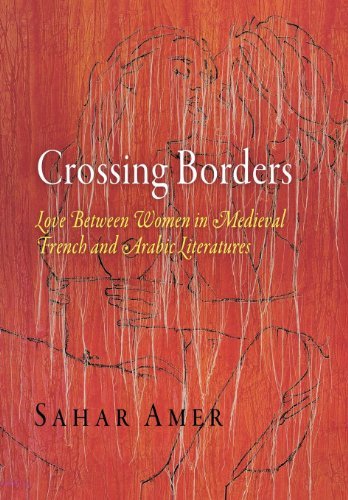Crossing Borders
Sahar Amer

The book is very well written, and offers the texts used for close reading in the original and in English, in parallel text in the case of French. The issue of the influence of these Arabic texts on these French texts, or the directionality of these exchanges, will not be persuasive for every reader. Researchers who work on Arabic will think of issues and sources that might be addressed in future work. However, what matters most is the interpretation of the material. In this regard, reading the two groups of texts together is interesting and useful both in terms of addressing homoerotic relationships and in terms of thinking about how medieval writers juxtaposed different perspectives on relationships.
Chapter one provides an introduction to the sources on female homoerotic relationships in both languages and the scholarship on them. In chapter two, the author treats a French narrative poem about social hierarchy, The Book of Manners, juxtaposing it with two monographic works on erotic life in Arabic, and in chapter three, she offers several versions of the romance Yde and Olive with the romance of Qamar al-Zaman and Princess Budur from The 1001 Nights. The presentations in chapters two and three focus primarily on intertextuality. The author reads the romance The Kite (as in the bird) in chapter four in light of the medieval Christian-Muslim trade in luxury goods, and compares it with a related episode from Qamar al-Zaman, and in chapter five, she reads The Kite against the background of the medieval Arabic literary portrayal of elegance (zarf), especially as concerns slave girls and singing slave girls. The readings in chapters four and five focus on intertextuality and intercultural relations.
While two chapters deal mainly with intertextual relations and two with intercultural relations, the methodology and the themes discussed unify the analysis. It may seem strange to consider the same text twice with different intertexts. However, this approach is effective in bringing out different perspectives on the texts without overwhelming readers (most of whom are thoroughly familiar with only one of the cultures) with one longer and more complicated reading. The author explains that reading texts from different cultures together enables us to pick up nuances in each tradition that remain hidden when texts from one culture are read alone or in isolation from their multicultural context of production.
While reading these French texts with these Arabic texts is persuasive and productive, and that is the most important thing, it is difficult to document the actual movement of texts and influence, especially in the case of a relatively less stable text such as The 1001 Nights, of military imagery for love that is so widespread in Arabic, or of the multifaceted social practices concerned with elegance or slave girls. If these Arabic texts and practices influenced French literature, writers might have accessed Arabic texts through Spanish, Hebrew, Latin or Italian. The book focuses on French and Arabic, but at one point refers to the equivalent of singing slave girls in Japanese and Greek culture, and I recall discussing similar themes with a colleague of Chinese literature.
Even when cultural connections are not significant or direct influence is difficult to document, such as in comparing Arabic and Japanese literature, or comparing The 1001 Nights with anything, the author’s observation that comparing texts from different cultures enables us to pick up nuances in each one, is still important. How is it possible to find same-sex love between women in literary traditions where these relationships are almost never discussed or even named? The author explains that in French literature, homo erotic relationships between women were denoted by a wider affective language, a broader range of behaviors, and a more expansive configuration of gender trouble than scholars have recognized. The interpretation is persuasive, and offers important insights into how medieval writers used female homoerotic relationships as an integral yet disruptive part of their portrayal of the dynamics of relationships in general.
The author cites two approaches to identifying female homoerotic relationships (the author prefers the term lesbian). In one, there is a lesbian continuum from friendship to erotic relationships; in the other, there are women practicing a range of lesbian-like behaviors. The behaviors entail some kind of resistance to patriarchy (I mean social order that privileges males and seniors, my definition). These behaviors include women who live in same-sex communities, resist marriage, do not marry, dress as men, work as prostitutes, or otherwise flout the norms of sexual propriety. However, these behaviors are not lesbian-like in and of themselves. The literary portrayal of lesbian relationships in these texts shows that these behaviors are contexts in which these relationships may take place. The author’s distinction between the intertextual and the intercultural will probably lead to further research and could be refined. We are dealing with the portrayal of relationships in texts as the author notes, the lesbian enjoyed a literary life in medieval French literature (and in Arabic) ~ Jocelyn Sharlet, Journal of the American Oriental Society, Vol. 129, No. 4 (October-December 2009) pp. 698-702
Check for it on:
Details
| ISBN | 9780812201086 |
| Genre | Asian Interest; Historical; History; Literary Criticism; Literary History |
| Publication Date | 2008 |
| Publisher | University of Pennsylvania Press |
| No. of Pages | 252 |
| LoC Classification | PQ155.L47 .A44 2008 |
| Language | English |
| Rating | Good |
| Subject | Arabic Literature – History And Criticism; French Literature – History And Criticism; Lesbians in literature |
| BookID | 2545 |

